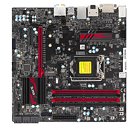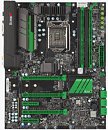Raevenlord
News Editor
- Joined
- Aug 12, 2016
- Messages
- 3,755 (1.16/day)
- Location
- Portugal
| System Name | The Ryzening |
|---|---|
| Processor | AMD Ryzen 9 5900X |
| Motherboard | MSI X570 MAG TOMAHAWK |
| Cooling | Lian Li Galahad 360mm AIO |
| Memory | 32 GB G.Skill Trident Z F4-3733 (4x 8 GB) |
| Video Card(s) | Gigabyte RTX 3070 Ti |
| Storage | Boot: Transcend MTE220S 2TB, Kintson A2000 1TB, Seagate Firewolf Pro 14 TB |
| Display(s) | Acer Nitro VG270UP (1440p 144 Hz IPS) |
| Case | Lian Li O11DX Dynamic White |
| Audio Device(s) | iFi Audio Zen DAC |
| Power Supply | Seasonic Focus+ 750 W |
| Mouse | Cooler Master Masterkeys Lite L |
| Keyboard | Cooler Master Masterkeys Lite L |
| Software | Windows 10 x64 |
SuperMicro may not be household name in consumer motherboards right now, but they once were a decent alternative in the market - or so I've been told by people much more knowledgeable than me in that regard, as I never laid my hands on one. The company is now more known for its server products, where it has focused most of its attention in the past decade - an effort that gave it a good, third-place hold in that market. And if the company can command such a market share in a much more requirements-heavy environment such as the server market demands, then it's likely those design decisions and developments will find themselves trickling down to the consumer side in any sort of consumer, gaming-grade product the company decided to tackle.
To that end, SuperMicro is gearing up to re introduce themselves to the consumer market, accompanying the wave of new technologies coming to the market in a few years - namely, PCIe Gen 4 and DDR5 memory. The company seems to think that this will mark a perfect opportunity for a strong comeback to the consumer market - where they now only offer a handful of motherboard solutions for Intel's CPUs. One such example is the C9Z390-PGW motherboard, based on Intel's Z390 chipset - with its 10-phase VRM design, PLC chip for doubling of PCIe lanes, and 10 Gigabit Lan. But not only on said "typical" consumer motherboard techonologies will SuperMicro be delivering - if the company has its way, anything from 5G, IoT, Mission Learning and Artificial Intelligence can be incorporated for some use case or another on consumer-grade motherboards, thus providing an axis of penetration for SuperMicro - and its entire partner eco-system.


The company is looking to leverage its IoT and server expertise that it has been cultivating in the last few years - with gaming grade products that will go up against the likes of ASUS Maximus and Gigabyte Aorus. Senior VP Vik Malyala told KitGuru that their company is also monitoring Ryzen's performance in the market, and reflected upon SuperMicro being one of the first companies to release Epyc-supporting motherboards. Perhaps we'll see the return of green to motherboards with a sexy tinge of environmentally-friendly operations.
View at TechPowerUp Main Site
To that end, SuperMicro is gearing up to re introduce themselves to the consumer market, accompanying the wave of new technologies coming to the market in a few years - namely, PCIe Gen 4 and DDR5 memory. The company seems to think that this will mark a perfect opportunity for a strong comeback to the consumer market - where they now only offer a handful of motherboard solutions for Intel's CPUs. One such example is the C9Z390-PGW motherboard, based on Intel's Z390 chipset - with its 10-phase VRM design, PLC chip for doubling of PCIe lanes, and 10 Gigabit Lan. But not only on said "typical" consumer motherboard techonologies will SuperMicro be delivering - if the company has its way, anything from 5G, IoT, Mission Learning and Artificial Intelligence can be incorporated for some use case or another on consumer-grade motherboards, thus providing an axis of penetration for SuperMicro - and its entire partner eco-system.


The company is looking to leverage its IoT and server expertise that it has been cultivating in the last few years - with gaming grade products that will go up against the likes of ASUS Maximus and Gigabyte Aorus. Senior VP Vik Malyala told KitGuru that their company is also monitoring Ryzen's performance in the market, and reflected upon SuperMicro being one of the first companies to release Epyc-supporting motherboards. Perhaps we'll see the return of green to motherboards with a sexy tinge of environmentally-friendly operations.
View at TechPowerUp Main Site




 .
.

